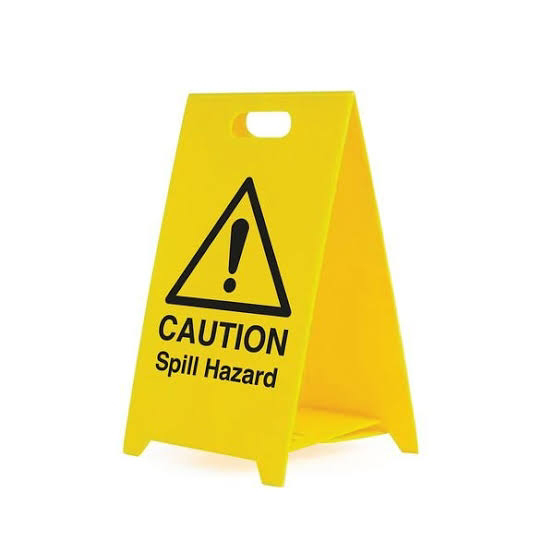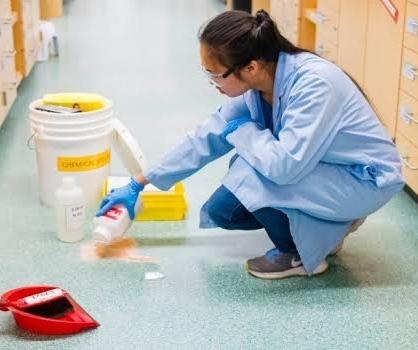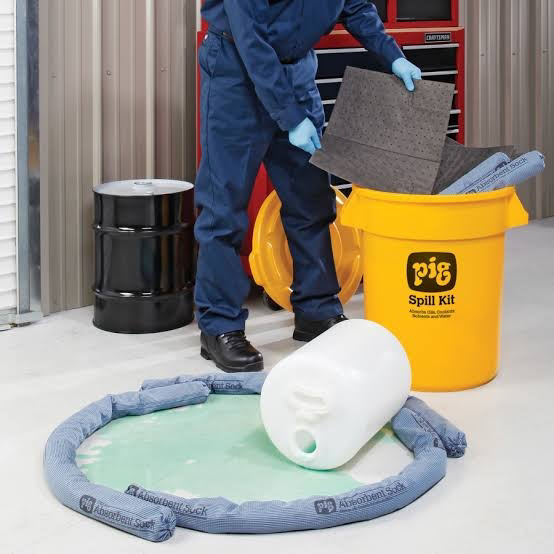SPILLAGE MANAGEMENT
In a clinical pathology laboratory or hospitals, hazardous substances such as body fluids, drugs, cleaning fluids and other chemicals are in very close proximity to hundreds of people each day. Thus in hospital or laboratory spillage of blood, body fluids or chemicals can occur at any time due to broken or faulty equipment or human error. Any such spill poses risk to the staff, visitors and patients who are extremely susceptible to infection.
Identify spillage firstly
Small volumes (few drops) of Spills (Mostly observe in Laboratory section):
Spill Kit: Following contains needs to be in spillage kit: Hypochlorite solution & water, sharp container, forceps, gloves, small broom, dust pan, tissue paper & yellow bag.
• Inform to all peoples /staff about the spill.
• Cover the spillage area immediately with
(signs, chain, stools, available mobile object)
Spillage kit assemble -
• Locate the spill kit and get at the area of spillage.
• Wear PPE.
• Needs to identify sodium hypochlorite solution concentration which is used in laboratory or Hospitals for preparation of 1% hypochlorite. (If you used 5 % sodium hypochlorite.)
• Pour 10 ml of 5 % sodium hypochlorite with 40 ml of water. This is freshly prepared 1 % sodium hypochlorite solution.
• Spread tissue paper (absorbent material on the spillage).
• Pour 1% sodium hypochlorite on the tissue paper.
• Contact period 30 minutes.
• Collect the tissue paper with dust pan & forceps. Discard it into yellow bag.
• If glass pieces discard it into sharps container
Disposal & disinfection -
• Contaminated Non-Plastic Spill material in yellow bag.
• PPE discarded in yellow bag.
• Sharp material discarded in blue coded box.
• Housekeeping cleans as per disinfection protocol (1% sodium hypochlorite)
Refill the Spillage kit next use
Fill Incident reports and submitted to safety officer for further investigation
Large volumes (>10 ml) of Spills:
1. Confine contaminated area
2. Wear workman’s gloves and other PPE appropriate to the task
3. Cover the spill with newspaper or appropriate absorbent material to prevent from spreading
4. Flood the spill with 10% hypochlorite solution. While flooding the spill with 10% hypochlorite solution it is to be ensured that both the spill and absorbent material is thoroughly wet
5. Alternatively, chlorine granules can be sprinkled on the spill first and then the paper put over it
6. Wait for five minutes.
7. Remove and discard the paper as infected waste
8. Wipe the area with paper moistened with 10% hypochlorite again if required until all visible soiling is cleaned
9. Wipe the area once with 10% hypochlorite and a cloth mop and allow drying naturally
10. All contaminated items used in the clean-up should be placed in a bio-hazardous bag for disposal.
Next one is which is only observe in chemical industry
Chemical Spill Management
Neutralising Acid Spills
Acid spills can be neutralised with sodium bicarbonate, sodium carbonate, or calcium carbonate.
Process
• Contain the liquid first•
• Sprinkle powder over the spill slowly, starting from the outside
• Acid is neutralised if effervescence ceases in the presence of excess bicarbonate
• Avoid breathing in the fine powder and the gas evolved (carbon dioxide).
Neutralising Alkali Spills
Alkali spills can be neutralised with sodium bisulphite, boric acid or oxalic acid. Many alkalis can result in serious burns to skin and eyes, so it is necessary to proceed with extreme caution.
Needs to be ventilation in area .
Eliminate all sources of ignition as neutralisation of alkali can produce heat. This includes removing all combustible materials that are close to the spill
Right any overturned containers where the spill originated or stop leak at source only if safe to do so
Avoid handling fluid even with nitrile gloves
Liberally apply the alkali neutraliser around the perimeter of the spill to limit the extent of spreading and continue sprinkling it towards the centre. This should be done until the entire spill is covered and there is no free liquid or liquid migration. The neutralisation reactions should occur 1-5 minutes after application
Stand clear as splattering of reaction products might occur. The heat and vigour of the reaction will depend on the type and concentration of the alkali being neutralised
The alkali will be neutralised when the reaction has stopped and there is no more fizzing from the liquid.
Caution
Neutralised alkalis may produce heat. Wait until mixtures have cooled before sweeping up spilled material
Avoid handling spilled material until absorption is complete
Use non-metal, non-sparking tools such as a broom, scoop or scraper to clean up neutralised spill. Take care not to overly disturb the neutralised spill.
(Reference OSHA guidlines)

















.png)



0 Comments